#Maria Theresia of Austria-Este
Text
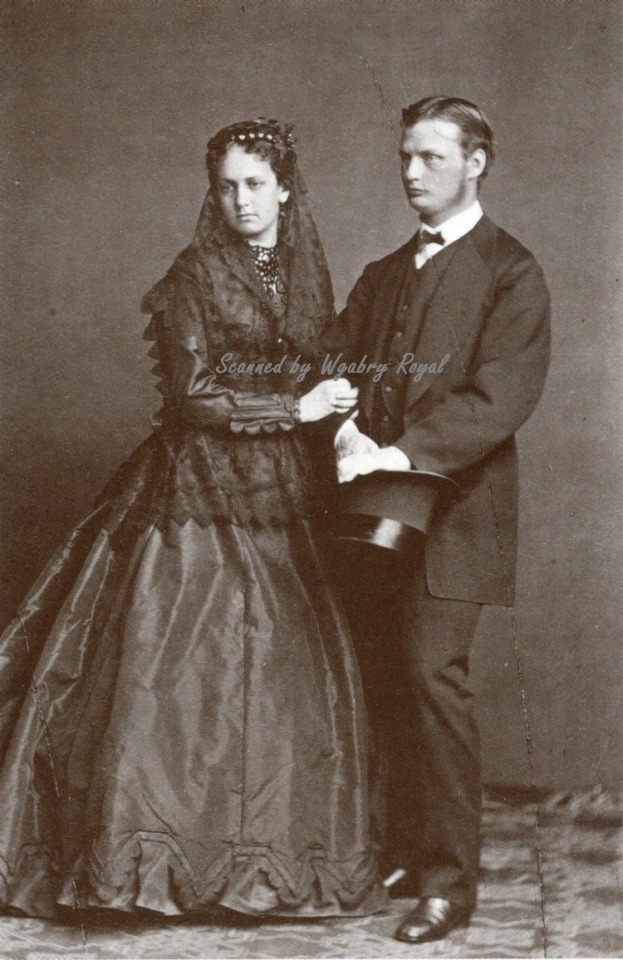
Ludwig III the last King of Bavaria and his future wife Maria Theresia, Archduchess of Austria-Este.
Source "Das Familienalbum von Kaiser Franz Joseph und Elisabeth"
16 notes
·
View notes
Text
Maria Leopoldine of Austria-Este
@microcosme11 had asked me about this lady of the Bavarian court:

Her name is Maria Leopoldine von Österreich-Este, and she played a huge role in making sure that Max Joseph, Eugène‘s future father-in-law, inherited the title of Elector of Bavaria. As a matter of fact, it‘s a highly educating tale of how to become elector in Munich in the first place.
Unfortunately, it will need a lot of explanation, as this takes us deeply into the rivalries and century-old feuds between the different German principalities that Napoleon Bonaparte would soon know to exploit so well. Let‘s just say, Habsburg (Austria) and Wittelsbach (Bavaria) had not seen eye to eye for quite some time when the Bavarian branch of House Wittelsbach, the one holding the position of Bavarian elector, was about to go extinct.
Many branches of the family went extinct around that time, in fact, and not only of this family. Be it that centuries of inbreeding finally took their toll, be it a general unwillingness to do more than the bare minimum to ensure the family had an appropriate heir (»No, no, no. We‘ve done our duty, we‘ve had one son. It‘s not our fault he died. We‘re not doing that again!«) or even to marry an appropriate but not necessarily attractive partner with whom you could have children able to inherit – the number of males in those princely families got rather low during the 18th century.

In 1777 – twelve years before the French Revolution, just for context – Maximilian Joseph III, the last elector from the old Bavarian branch of the Wittelsbach family, died without a son. There were of course more branches of the family, most importantly the branch that held the electorate of the Palatinate, and then some less important, not ruling branches, like the Zweibrücken-Birkenfelds. Now, technically, if a German prince died without an heir, things would get all medieval: the liege – the Bavarian electorate, in this case - would fall back to the liege lord. The emperor.
The Habsburg emperor in Vienna! No f-ing way!
... said not only the Bavarians but also the kings of France and Prussia, who had no interest in Austria gaining that much territory. In order to prevent it from happening, the different Wittelsbach branches in a multitude of »house contracts« had declared several years before that the family branches would all inherit from each other if one went extinct. The Austrians might have protested against that arrangement but they had just done something quite similar in order to ensure that the last emperor‘s daughter Maria Theresia could inherit, so they were in a bad position to argue. Which doesn‘t mean they didn‘t. But after some more bad blood, even a »War of the Bavarian Succession« that is a funny story in itself, things settled down, and a guy named Karl Theodor (Charles Theodore) became elector of both Bavaria and the Palatinate.

There was a huge down-side to this advancement, from his perspective: he had to move to Bavaria. Uncivilised, almost medieval, hilly-billy Bavaria. He hated that place, and for good reasons. He was a very cultivated person, and this was a very uncultivated place (according to some, it still is *coughcough*). The Bavarians, as to them, liked this new guy in Munich about as much as he liked them. And another problem was already looming on the horizon: Karl Theodor had plenty of children – but only one son with his wife, and this son happened to die a day after he was born. Apparently this was one of those cases where the spouses thought once had been enough and refused to give it another try. And Karl Theodor could not even marry somebody else because – catholic. No divorce. And his unloved wife was in good health. To sum up: No immediate heir in this family either.
Which brings us to the Zweibrücken family branch. At the time when Karl Theodor moved to Munich, this branch of the Wittelsbach family consisted of two brothers: Karl August and Maximilian Joseph (yes, that‘s our Max, future king of Bavaria). Their father, Friedrich Michael, had died young as a military officer in French service, so they had grown up at the court of their uncle, Friedrich Michael‘s older brother Christian. Christian – just saying – had simply refused to marry a partner of equal birth and instead conducted a morganatic marriage with a French actress. A very happy one, by the way. The burden to ensure the family would continue thus had fallen to Friedrich Michael, who had married a sister of Karl Theodor‘s wife, had made her four kids (two sons, two daughters) and bedded pretty much every willing lady of the French court before accusing his wife of adultery, locking her up in some monastery (Max Joseph probably saw his mother last when he was three years old), and then getting himself killed in some war or other.
By 1778, both Friedrich Michael and Christian were dead, and as Christian‘s many children could not inherit his titles, Karl August had become Count Palatine of Zweibrücken (Deux-Ponts in French). Due to his »uncle« Karl Theodor‘s lack of a legitimate son, he and his younger brother Max Joseph also were the next heirs to the combined Bavarian and Palatine electorate.

(Karl August, older brother to future king Max Joseph)
Meanwhile in Munich, Karl Theodor really got annoyed with this gruesome country he had been forced to move into. However, for the first time in a long while this was a Bavarian elector who had good relations with the Habsburgs. After some negotiations between Munich and Vienna Karl Theodor and emperor Joseph II came up with a plan that would make everybody happy: Karl Theodor would exchange the Bavarian territory (or some portion of it) for the Austrian Netherlands. Austria would finally add Bavaria to its territory, and Karl Theodor could move to a nicer place.
This caused an uproar among the Bavarian population. Becoming Austrians? Never! - The Bavarian estates sent delegation after delegation to the Zweibrücken nephews with desperate pleas for help (they also paid these nephews‘ debts). Karl August and Max Joseph immediately protested against the plan, and it turned out that according to the fineprint in those house contracts mentioned above Karl Theodor could not make the deal with Vienna without his nephews‘ consent. Bummer.
France and Prussia also put a word in, and France did even more: When Karl August‘s only son (yet another only child) died in 1784, with little chance for a legitimate replacement, the French king personally made sure that Max Joseph, the younger brother, a great womanizer and obstinate bachelor, would get married to an appropriate lady who could give birth to many legitimate heirs of the Bavarian electorate (oh, and Louis also paid Max Joseph‘s debts. That‘s a recurring theme in the story). Max Joseph, after lots of wailing and resisting, was finally dragged in front of the altar in 1785 and, to his great surprise, found that he loved marriage life, family and children. Not necessarily enough to give up on his womanizing ways. But this whole family thing, having kids and stuff? That was also kinda fun.

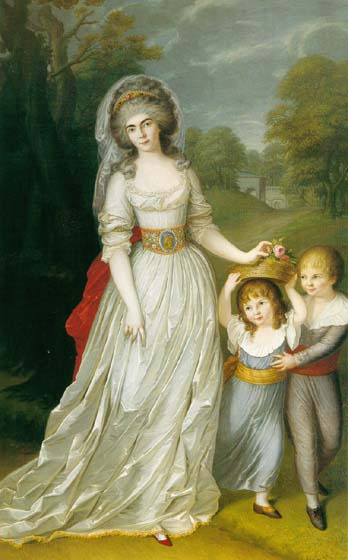
(Max Joseph’s first wife Auguste Wilhelmine and their two oldest children, crown prince Ludwig and - yes, that’s little Auguste)
Let‘s fast forward a little: The French Revolution breaks out. Max Joseph, so far one of the many foreign princes in French service, looses everything and, with a wife and five children, becomes a refugee. For some time, so does his brother. Then over the next years, many people die: Max‘s first wife (he will quickly remarry), one of his daughters - and his brother Karl August. Making Max Joseph the heir apparent to the electorate of the Palatinate and of Bavaria.
Except that, in 1794, one more person died: Elector Karl Theodor‘s wife. The Austrians acted quickly and offered the mourning widower (who had 70 years of age) an archduchess as new bride in order to produce an heir with, just so Bavaria would not fall into the clutches of this former French colonel Max Joseph von Zweibrücken who was very unlikely to make any similar deals with the Habsburgs.
And now we finally can introduce the lady this is all about:

Maria Leopoldine was the daughter of Ferdinand Karl von Österreich-Este, who in turn was one of the many children of Maria Theresia (i.e. a brother to the emperors Joseph and Leopold and queens Marie Antoinette and Maria Carolina of Naples) and ruled in Milan. (A year after Maria Leopoldine had married, her family would be kicked out of their home by one Napoleon Bonaparte and his army of Italy). She was 19 years old when she was ordered to marry 70-year-old elector Karl Theodor, and a young lady with lots of self-esteem. Allegedly, when she first saw the bridegroom‘s portrait, she exclaimed: »Thank god he‘s already that old!« - Obviously, it was love on first sight.
The marriage life of the happy newly-weds turned out to be just as full of harmony and roses as could be expected: Maria Leopoldine locked her bedroom door. Well, at least for her husband. Not so much for anybody else. And to make matters worse, her new »nephew« Max Joseph showed up in Munich, as he did from time to time. Just to remind Karl Theodor who was his heir probably, but this time ostensibly to pay his homage to the new aunt Maria Leopoldine. According to a story crown prince Ludwig was told much later, Max Joseph was quite thorough about this task and, unlike his uncle, did make it into Maria Leopoldine‘s bedroom. Did I mention Max never quite gave up on his womanizing ways?
In any case, Maria Lepoldine had made up her mind: She very much preferred the nephew over her husband, thank you for asking. If there was anything she could do to ensure the Austrians (that is, her own Habsburg family!) would not receive Bavaria, she would do it.
Turns out, she could do a lot.
Fast forward to 1799. Karl Theodor suffers from a stroke while playing cards. It‘s not his first, but this one is serious. The old elector still breathes, but the doctors are agreed there‘s nothing they can do. It‘s just a matter of time now.
Time that the Austrian ambassadors in Munich want to use. Contracts for an exchange or sale of Bavarian territory to Austria have long been drawn up, all they need is the elector‘s signature! Surely now, in his last hours, Karl Theodor will not hesitate any longer? They enter the Munich Residence, talk or bribe their way into the private rooms of the elector’s family, into the elector‘s rooms, to his bedroom - and then there‘s somebody on the doorstep. Maria Leopoldine.
And. She. Will. Not. Move. - Forget Gandalf against the Balrog of Moria. Maria Leopoldine against the Habsburg ambassador was the real thing. In the end, the Austrians, most likely after lots of cursing and footstomping, had to leave. In case they hoped they would be luckier at another occasion, they were disappointed: For the first time during their marriage, Maria Leopoldine focused solely on her husband and gave him all her attention, until he breathed his last.
At which point she had all gates of Munich locked. All Austrian couriers on their way to inform Vienna were turned back. The only dispatch that did go out was one to Max Joseph, in which Maria Leopoldine declared herself Max‘s devoted subject and invited him to come to Munich and take over power as soon as possible.
Which Max did. Not necessarily as quickly and forcefully as Maria Leopoldine had acted. But it sufficed.
There was one more point in which Maria Leopoldine helped Max a lot. After her husband‘s death, state officials in the presence of the Austrian ambassador had an interview with her, inquiring if Maria Leopoldine happened to be pregnant. Because a son by Karl Theodor, even posthumously born, would have inherited before Max Joseph. She answered »No«.
Now, as chance would have it, some months later, she went on a lengthy journey that we are very badly informed about, and only returned a year later, after most likely having given birth to a child somewhere on the way. A child whose father surely had not been Karl Theodor. But the Austrians probably would not have cared.
Maria Leopoldine stayed in Munich, much beloved by Max Joseph, and became the enfant terrible of his court, had lovers in abundance, excelled at investing her money, at some point bought a farm where she, if need be, personally helped with the hay-making, and even married morganatically (possibly so she had an official father for her children). She was a close friend of Eugène but not so much of his wife. Maybe she never quite forgave Auguste that her arranged marriage had turned out so well when her own had been such a disaster.

(Maria Leopoldine in later years, with her two sons)
#Maria Leopoldine of Austria-Este#Bavarian court#Munich#max joseph#charles theodore#habsburg and wittelsbach
26 notes
·
View notes
Photo
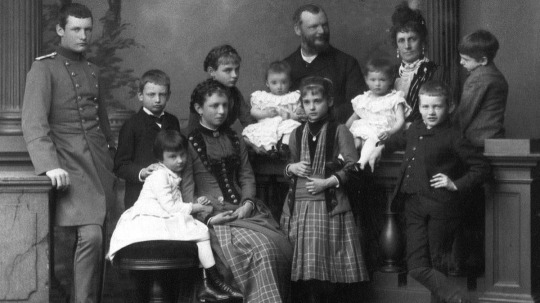
Ludwig III of Bavaria with his family, 1885
#Ludwig III of Bavaria#Maria Theresia of Austria-Este#Rupprecht Crown Prince of Bavaria#Princess Adelgunde of Bavaria#Maria Ludwiga Princess of Bavaria#Princess Mathilde of Bavaria#Prince Wolfgang of Bavaria#Prince Franz of Bavaria#Prince Karl of Bavaria#Princess Hildegard of Bavaria#Princess Wiltrud of Bavaria#1880s#wittelsbach#bavarian royal family
12 notes
·
View notes
Photo

Maria Theresa of Austra-Este, Queen of Sardinia (1 November 1773 - 29 March 1832)
#maria theresa of austria-este#maria theresia josefa johanna#queen of sardinia#daughter of archduke ferdinand of austria#wife of victor emmanuel i of sardinia#history#women in history#18th century#19th century#art
38 notes
·
View notes
Text
Royal Wedding on 26 November 1924.
Wilhelm Karl, Duke of Urach (60) and Princess Wiltrud of Bavaria (40).
The bridegroom was the eldest son of Wilhelm, Duke of Urach and his second wife, Princess Florestine of Monaco. He was previously married to Duchess Amalie of Bavaria who died in 1912.

The bride was the sixth daughter of King Ludwig III of Bavaria and his wife, Archduchess Maria Theresa of Austria-Este.
The bridal couple with Princess Wiltrud's niece and nephew, Countess Maria Theresia and Count Johann Kaspar von Preysing-Lichtenegg-Moos.
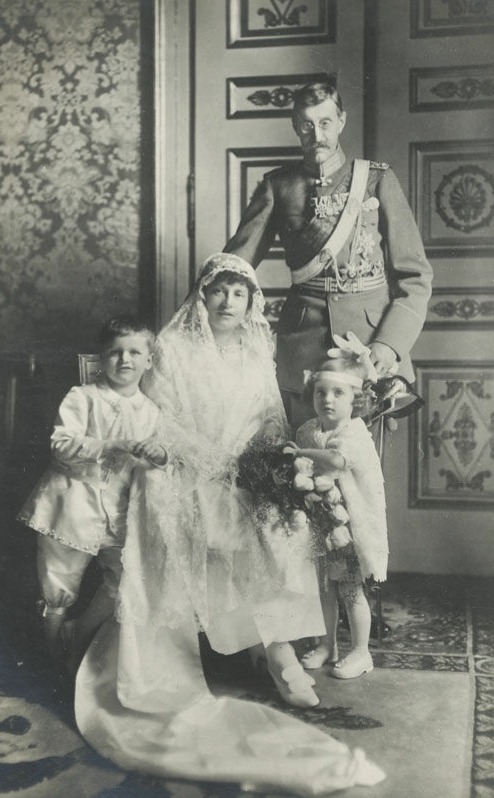
The wedding guests

Back row: Prince Eberhard of Urach, Prince Wilhelm of Urach, Prince Karl Aloys of Liechtenstein, Prince Karl Gero of Urach and Prince Albrecht of Urach.
Front row: Princess Margarete of Urach, Princess Karl Aloys of Liechtenstein, Princess Wiltrud of Bavaria, Wilhelm Karl, Duke of Urach, Princess Karola of Urach and Princess Mechthilde of Urach.
#princess wiltrud of bavaria#wilhelm karl duke of urach#princess margarete of urach#princess elisabeth of urach#princess karl aloys of liechtenstein#prince karl aloys of liechtenstein#prince eberhard of urach#princess karola of urach#princess mechthilde of urach#prince wilhelm of urach#karl gero duke of urach#Count Johann Kaspar von Preysing-Lichtenegg-Moos#countess maria theresia von Preysing-Lichtenegg-Moos#royal weddings#1924#1920s#urach#german royalty#german royal#prince albrecht of urach
12 notes
·
View notes
Photo








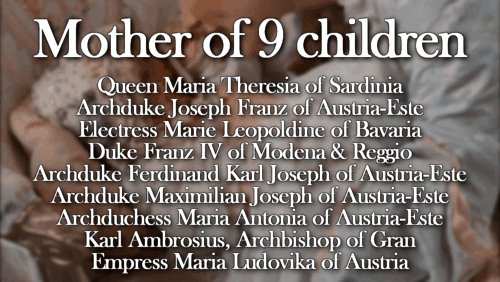

House of Este & House of Habsburg: Maria Beatrice d’Este
Maria Beatrice was born as the oldest child of Ercole III d’Este, The Duke of Modena & Reggio, and his wife Maria Teresa Cybo-Malaspina, The Duchess of Massa and Carrara. Her parents marriage did not work out and they lived mostly seperate lives. Because of this Maria Beatrice only had one younger brother who died when he was still a baby. This way Maria Beatrice became the sole heir of four duchies.
As an heiress of so many titles and lands, she was of course an interesting marriage candidate. Especially for the ambitious Maria Theresia of Austria who intended to strengthen the power and influence of the House of Habsburg all over Europe by marriage. Maria Beatrice and Archduke Ferdinand Karl were betrothed from an early age. In fact, Maria Beatrice was even four years older than her husband.
On October 15th, 1771, Ferdinand Karl and Maria Beatrice were wed in Milan. For the occasion, the 15-year-old Wolfgang Amadeus Mozart composed the opera Ascanio in Alba. The marriage is described as a happy one and resulted in 9 children being born who again married quite powerful people. The youngest daughter would even become the last Holy Roman and the first Austrian Empress. But this was not the only marriage contracted within the Habsburg family tree. The heir Franz IV married his niece Maria Beatrix of Savoy, the daughter of his oldest sister Queen Maria Theresia of Sardinia.
Maria Beatrice inherited the duchies of Massa & Carrara in 1790 after the death of her mother. Unfortunately only a few years later the French Revolution swept through Europe and Napoleon declared merged them to the Cispaldine Republic which then again joined the Cisalpine Republic a year later in 1797. The family fled to Vienna and the close by city of Wiener Neustadt. According to the Treaty of Lunéville received estates in Breisgau and Ortenau, which both are located in modern-day Germany.
When Maria Beatrice’ father died in 1803, she did not inherit her father’s duchies but instead her rights went to her oldest son since the duchies did not allow a female succession when there was a male candidate. Archduke Ferdinand Karl died in 1806. Two years later, Maria Beatrice became the Empress’ mother by her youngest daughter’s marriage to her patenal cousin Francis II. From this time, letters survived showing her lively correspondence with her daughter in which she expresses her deep interest in politics.
At the Congress of Vienna in 1814, Maria Beatrice received her duchies Carrara and Massa back as well as the imperial fiefdom of Lunigiana. Her son became his grandfather’s successor as The Duke of Modena and Reggio.
Maria Beatrice died on November 14th, 1829, at the age of 79 in Vienna. Her duchies were inherited by her son and merged with his duchies. Maria Beatrice is buried in the Imperial Crypt in Vienna. Her house in at Herrengasse in Vienna stil exists and is called Palais Modena. Furthermore a Viennese park (Modenapark) as well as a street (Beatrixgasse) and a square (Am Modenapark) have been named in her honor. Together with her husband, she founded the House of Austria-Este (also known as Habsburg-Este), a cadet branch of the House of Habsburg-Lorraine.
// Virginie Ledoyen in Farewell, my Queen (2012)
#historyedit#women in history#historic women#house of habsburg#european history#Austrian history#Italian history#Maria Beatrice d'Este#House of Este#House of Austria-Este#House of Habsburg-Lorraine#1700s#1800s#18th century#19th century
144 notes
·
View notes
Photo

Unknown, ‘Queen Maria Theresia of Austria as the Goddess Minerva’, n.d., unsold for est. 60,000 - 70,000 SEK in Bukowski’s Classic Sale, December 2015
Maria Theresa (b.1717 - d. 1780) was the heir - and the last ruler of - the domains of the Hapsburg family, who ruled a significant portion of Europe in the 1500s to the 1700s. As the eldest surviving child of her father, Holy Roman Emperor Charles VI, and with her only brother dead after seven months of life, she was the inheritor of his realms; this was not uncontested however, and was the catalyst for the War of the Austrian Succession.
Her marriage to Francis, Duke of Lorraine (b.1708 - d.1765) was successful, in both love - the two holding a genuine love for one another and her reaction to his death similar to Queen Victoria’s reaction to Prince Albert’s death over a hundred years later - and in progeny, resulting in 16 births. Of the surviving children, two would become Holy Roman Emperors (Joseph II & Leopold II), as well as Duchess of Teschen (Maria Christina), Duchess of Parma (Maria Amalia), Queen of Naples and Sicily (Maria Carolina), Duke of Briesgau & Massa (Ferdinand), Queen of France (Marie Antoinette), and Archbishop-Elector of Cologne (Maximillian Franz).
7 notes
·
View notes
Photo

Princess Adelgunde Marie Auguste Therese of Bavaria (17 October 1870, Munich – 4 January 1958, Sigmaringen) was a Princess of Bavaria by birth and Princess of Hohenzollern through her marriage to William, Prince of Hohenzollern. Adelgunde was the second eldest child of Ludwig III of Bavaria and his wife Maria Theresia of Austria-Este.
#Aldegunde of Bavaria#House Wittelsbach#XX century#people#portrait#photo#photography#Black and White
0 notes
Text
Videosalas del 28 de junio al 4 de julio

VIDEOSALA CAAV
Lerdo de Tejada 2071, entre Marsella y Chapultepec. T/3615-8470. Entrada libre.
DRAMA
LA OTRA CARA DEL AMOR
D: Ken Russell
Con Richard Chamberlain, Glenda Jackson, Christopher Gable
Reino Unido, 1970. d: 124 min.
Biografía del compositor ruso Tchaikovsky, un hombre torturado que sólo era feliz con su música. Se casa con Nina Milukova, una joven apasionada y neurótica. Un matrimonio fracasado que le lleva al borde del suicidio y acaba con la salud mental de su mujer. Las relaciones de Tchaikowsky con su mecenas, Madame von Meck, también se deterioran cuando ésta se entera de su pasado amoroso.
Viernes 28, 16:00 y 18:15 h
DRAMA
MADEMOISELLE PARADIS
D: Barbara Albert
Con Susanne Wuest, Maria-Victoria Dragus, Devid Striesow
Austria, 2017. d: 90 min.
Viena, 1777. Maria Theresia Paradis, niña prodigio, pianista ciega de 18 años, perdió la vista cuando tenía tres años. Sus padres la llevan a la finca del ‘doctor milagro’ Franz Anton Mesmer, donde se une a un grupo de estrafalarios pacientes. Disfruta del ambiente liberal de la casa, pero empieza a notar que, mientras el tratamiento le está devolviendo la vista, está perdiendo su apreciado virtuosismo musical.
Sábado 29 y domingo 30, 16:00 y 18:00 h
CINEFORO UDEG. Av. Juárez esq. Enrique Díaz de León, piso -1. T/3826-7297. Boleto: $45 general; $30 maestros y universitarios con credencial. www.cineforo.udg.mx
DRAMA
ENTRE LOS HOMBRES DE BIEN
D: Caio Cavechini y Carlos Juliano
Brasil, 2016. d: 106 min.
El Congreso brasileño está tomado por el partido conservador Bancada BBB. Este documental sigue, a lo largo de tres años, los pasos del diputado Jean Wyllys, el único diputado abiertamente homosexual, en su labor como vocero de la causa LGBT y la lucha por derechos como el matrimonio entre personas del mismo sexo.
Del 27 al 30 de junio, 18:00 h
DRAMA
POTENTIAE
D: Javier Toscano
México, 2016. d: 93 min.
Es el retrato íntimo de personas con diferentes discapacidades en la ciudad de México. Estas personas forman grupos de acuerdo con su condición específica, convirtiéndose así en un organismo viviente, un ensamble a través del cual los individuos se compensan a partir de las capacidades de los demás.
Del 1 al 3 de julio, 18:00 h
BIBLIOTECA PÚBLICA DEL ESTADO DE JALISCO JUAN JOSÉ ARREOLA. Periférico Norte Manuel Gómez Morín 1695.Sala de cine, piso 1. T/3836-4530. Entrada GRATIS.
Cine y literatura
DRAMA
JANE BUSCA TRABAJO
D: Christopher Hodson
Sábado 29, 12:00 h
DRAMA
LA HOMBRIA DE EDUARDO ROBINSON
D: Christopher Hodson
Sábado 29, 13:00 h
Ciclo infantil
ANIMACION
EL GIGANTE DE HIERRO
D: Brad Bird
Estados Unidos, 1999. d: 86 min.
En 1957, en la pequeña localidad de Rockwell, alguien ha visto cómo un enorme hombre metálico caía al mar. Un imaginativo niño descubre que se trata de un robot gigante, cuyo apetito de metal es insaciable. Entre ambos nace una fuerte amistad, pero el gobierno envía a un agente para investigar los hechos. El niño esconde a su nuevo compañero en la chatarrería de un amigo. Pero los habitantes del pueblo comienzan a sentirse aterrados porque creen que es una nueva amenaza en plena Guerra Fría.
Viernes 28, 16:00; sábado 29 y domingo 30, 13:00 h
No.1137. 280619
0 notes
Photo
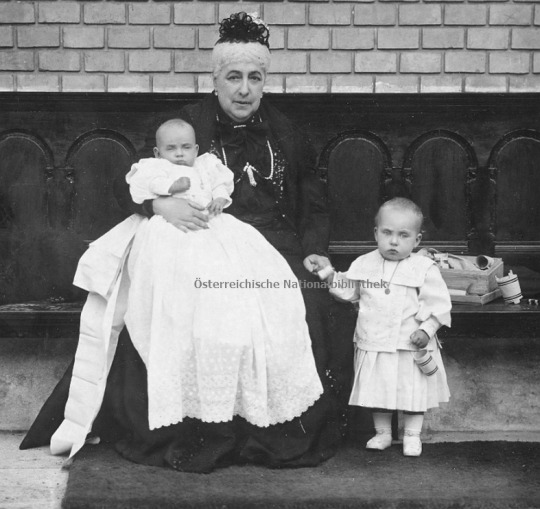
A very beautiful photo of Archduchess Elisabeth Franziska Maria of Austria along with his great grandchildren Maria Antonietta e Maria Cristina of Bourbon-Two Sicilies, daughters of Princess Maria Ludwiga Theresia of Bavaria (herself daughter of Maria Theresa of Austria-Este married to the future Ludwig III, last king of Bavaria). Source on the photo
17 notes
·
View notes
Text

Princess Maria Ludwiga of Bavaria (1872-1954 ) and Prince Ferdinand Pius, Duke of Calabria (1869-1960) in 1897 around the time of their marriage.
Maria Ludwiga's parents were Ludwig III of Bavaria and Archduchess Maria Theresia of Austria-Este. Through her mother, she was related to Stephanie, Crown Princess of Austria and King Alfonso XIII of Spain.
Ferdinand was the eldest child and son of Prince Alfonso, Count of Caserta and his wife Princess Maria Antonietta of Bourbon-Two Sicilies. He was a grandson of Ferdinand III of the Two Sicilies and and older brother of Prince Carlos of Bourbon-Two Sicilies later Don Carlos, Infante of Spain.
#princess maria ludwiga of bavaria#Duchess Maria Ludwiga of calabria#italian royal#italian royalty#bourbon-two sicilies#bavarian#german royal#german royalty#1897#1890s fashion#1890s#late 1890s#prince ferdinand pius duke of calabria
19 notes
·
View notes
Text

Archduchess Elisabeth Franziska of Austria (1831-1903). 1890s.
She was born in Ofen (Buda), Hungary, the daughter of Palatine Joseph of Hungary (1776–1847) and his third wife Princess Maria Dorothea of Württemberg.
In 1847 she married Archduke Ferdinand Karl of Austria-Este, Prince of Modena (1821-1849), who died shortly after the birth of their daughter Maria Theresia, who later became the last Bavarian queen. Her husband also came from the House of Habsburg-Lorraine. He was a great-grandson of Empress Maria Theresa via Ferdinand Karl von Österreich-Este (1754-1806).
In 1854 Elisabeth entered into a second marriage with her first cousin Archduke Karl Ferdinand of Austria (1818–1874). The marriage arose under pressure from Archduchess Sophie. The latter noticed that the young emperor Franz Joseph had an eye on Elisabeth. Due to the attempted assassination attempt on her son, the archduchess did not want the Hungarian daughter-in-law and the constant unrest in parts of Hungary. Elisabeth and Karl Ferdinand's marriage was a happy one. Six children emerged from it, four of which survived infancy.
Widowed again in 1874 at the age of 43, Elisabeth received zealous support from her brother-in-law Albrecht when raising her children. This appointed her son Friedrich as the main heir. Elisabeth was the patron of several social institutions. She was very fond of music. Johannes Brahms was invited around 1882 to play rehearsals of his piano quintet in their palace.
She was a maternal grandmother of King Alfonso XIII of Spain.
Through her mother, she was a first cousin of Marie, Queen of Hanover, King William II of Württemberg, Princess Leopoldine of Hohenlohe-Langenburg and Grand Duchess Alexandra Iosifovna of Russia.
Elisabeth's youngest sister was Marie Henriette, Queen consort of the Belgians.
"Do you like her? Me neither". In this unpromising way, King Alfonso XII addressed his trusted man Pepe Osorio after meeting his future wife Archduchess Maria Christina for the first time. And then he blurted out, "You must have noticed that the one who's the bomb is my mother-in-law." They had come to the French town of Arcachon on August 22, 1879 to see in person if his fiancée repelled him or could bear the marriage. Judging by his words, Archduchess Maria Christina did not arouse much enthusiasm in him - she was not his type; Alfonso liked brunettes, round-faced and voluptuos, and Maria Christina was blond and slender - but the young woman seemed pleasant enough to continue with the state wedding project".
Photograph by F. Schiller.
13 notes
·
View notes
Text
Master Post - Members by birth
Disclaimer: Houses that rule(d)/reside(d) in other countries but originally came from German and/or Austrian territories and/or are generally regarded as belonging to this cultural room are listed among the German & Austrian Houses.
German & Austrian Houses
House of Ascania
Princess Sophie of Anhalt-Zerbst aka Catherine the Great
House of Coburg (Cadet branch of the House of Wettin)
Princess Alice of the United Kingdom, The Grand Duchess of Hesse and by Rhine
Princess Antoinette of Saxe-Coburg-Saalfeld, Duchess of Württemberg
Princess Charlotte of Belgium, The Empress of Mexico, Archduchess of Austria
Princess Stéphanie of Belgium, Crown Princess of Austria, Hungary & Bohemia
Princess Victoria of Great Britain and Ireland, Princess Royal, The German Empress
Victoria of Saxe-Coburg-Saalfeld, The Princess of Leiningen, The Duchess of Kent
House of Griffin
Elizabeth of Pomerania, Holy Roman Empress
House of Habsburg
Archduchess Johanna of Austria, The Grand Duchess of Tuscany
Archduchess Maria Amalia of Austria, Holy Roman Empress, The Electress of Bavaria
Archduchess Maria Anna of Austria, Princess of Lorraine and Bar
Archduchess Maria Antonia of Austria, The Electress of Bavaria
Archduchess Maria Antonia “Marie Antoinette” of Austria, The Queen of France and Navarre
Archduchess Maria Leopoldine of Austria, The Empress of Brazil, Queen of Portugal & the Algarves
Maria Theresia, The Archduchess of Austria, Holy Roman Empress
Archduchess Sophie of Austria
House of Hanover (Cadet branch of the House of Welf)
Princess Sophia Dorothea of Hanover, The Queen in Prussia
Queen Victoria of the United Kingdom, Empress of India
House of Hesse
Princess Alix of Hesse and by Rhine, Empress Alexandra Feodorovna of Russia
Princess Elisabeth of Hesse and by Rhine, Grand Duchess Elizabeth Feodorovna of Russia
House of Hohenlohe-Langenburg
Princess Adelheid of Hohenlohe-Langenburg, The Duchess of Schleswig-Holstein
Princess Feodora of Hohenlohe-Langenburg, The Duchess of Saxe-Meiningen
House of Hohenstaufen
Elisabeth “Beatrix” of Swabia, The Queen of Castile, León & Galicia
Konstanze “Anna” of Hohenstaufen, The Empress of Nicaea
House of Hohenzollern
Princess Anna Amalia of Prussia
Princess Caroline of Ansbach, The Queen of Great Britain & Ireland, The Electress of Hanover
Princess Elisabeth of Brandenburg, The Duchess of Brunswick-Calenberg-Göttingen
Princess Luise of Prussia, Princess Radziwiłł
Princess Maria Eleonora of Brandenburg, The Queen of Sweden
Princess Marie of Prussia, The Queen of Bavaria
Princess Wilhelmine of Prussia, The Margravine of Brandenburg-Bayreuth
House of La Marck
Amalia of Cleves
Anne of Cleves, The Queen of England
Sybille of Cleves, The Electress of Saxony
House of Leiningen
Princess Feodora of Leiningen, The Princess of Hohenlohe-Langenburg
House of Liechtenstein
Princess Sophie of Liechtenstein, Countess Esterházy de Galantha
House of Mecklenburg
Charlotte of Mecklenburg-Strelitz, The Queen of Great Britain, Ireland & Hanover
Elisabeth of Mecklenburg-Schwerin, Princess of Brunswick-Lüneburg aka Grand Duchess Anna Leopoldovna of Russia
Friederike (Federica) of Mecklenburg-Strelitz, The Queen of Hanover
Louise of Mecklenburg-Strelitz, The Queen of Prussia
Therese of Mecklenburg-Strelitz, The Princess of Thurn and Taxis
House of Northeim
Richenza of Northeim, Holy Roman Empress
House of Oldenburg
Augusta Victoria of Schleswig-Holstein, German Empress
Princess Cecilie of Greece & Denmark, The Hereditary Grand Duchess of Hesse and by Rhine
House of Reuß
Princess Hermine Reuß of Greiz, “German Empress”
House of Thurn and Taxis
Princes Marie Auguste of Thurn and Taxis, Duchess of Württemberg
House of Welf
Adelaide of Burgundy, Holy Roman Empress, Queen of Italy
Princess Caroline of Brunswick-Wolfenbüttel, The Queen of the United Kingdom & Hanover
Elisabeth Christine of Brunswick-Wolfenbüttel, Holy Roman Empress
Elisabeth Christine of Brunswick-Wolfenbüttel-Bevern, The Queen in & of Prussia
Princess Juliane of Brunswick-Wolfenbüttel-Bevern, The Queen of Denmark and Norway
House of Wettin
Adelheid (Adelaide) of Saxe-Meiningen, The Queen of the United Kingdom and Hanover
Princess Augusta of Saxe-Weimar-Eisenach, German Empress
Princess Christina of Saxony, The Landgravine of Hesse
Princess Luise (Louise) of Saxe-Gotha-Altenburg, The Duchess of Saxe-Coburg-Saalfeld, The Countess of Pölzig and Beiersdorf
House of Wied-Neuwied
Princess Elisabeth of Wied, The Queen & Princess of Romania
House of Wittelsbach
Princess Alexandra of Bavaria
Princess Amalie Auguste of Bavaria, The Queen of Saxony
Eleonore Magdalene of Neuburg, Holy Roman Empress
Elisabeth “Sisi” in Bavaria, The Empress of Austria
Elisabeth (Isabeau) of Bavaria, The Queen of France
Princess Elisabeth Ludovika of Bavaria, The Queen of Prussia
Helene “Néné” in Bavaria, The Hereditary Princess of Thurn and Taxis
Princess Ludovika of Bavaria, The Duchess in Bavaria
Princess Maria Anna of Bavaria, The Archduchess of Inner Austria-Styria
Princess Maria Anna of Bavaria, The Queen of Saxony
Marie in Bavaria, The Queen of Two Sicilies
Baroness Marie Louise of Wallersee, Countess of Larisch
Mathilde in Bavaria, The Countess of Trani
Sophie in Bavaria, The Duchess of Alençon
Princess Sophie of Bavaria, Archduchess of Austria
House of Württemberg
Mary of Teck, The Queen of the United Kingdom & British Dominions, Empress of India
Princess Sophie of Württemberg, The Queen of the Netherlands
Minor Nobles
Anna Constantia of Brockdorff, The Imperial Countess of Cosel
Katharina von Bora, Mrs Martin Luther
Baroness Louise Lehzen
Baroness Marie “Mary” of Vetsera
Sophie Botta, The Dark Countess of Hildburghausen
Sophie of Pannwitz, Countess of Voß
Foreign Houses
House of Albret
Jeanne d’Albret, The Queen of Navarre, 1. The Duchess of Jülich-Cleves-Berg and 2. The Duchess of Vendôme
House of Aviz
Infanta Eleonor of Portugal, Holy Roman Empress
House of Bourbon
Princess Louise d’Orléans, Princess Alfons of Bavaria
Byzantine Imperial Family
Princess Eudokia Laskarina of Nicaea, The Hereditary Duchess of Austria
Irene of Byzantium, The Queen of the Germans, The Duchess of Swabia
Princess Theodora Angelina, The Duchess of Austria & Styria
Princess Theodora Komnene of Byzantium, The Duchess of Bavaria & Austria
Theophanu, Holy Roman Empress
House of Chotek
Countess Sophie Chotek of Chotkowa and Wognin, The Duchess of Hohenberg
House of Este
Maria Beatrice d’Este, The Duchess of Massa & Carrara, Archduchess of Austria
House of Jagiellon
Jadwiga (Hedwig) Jagiellon, The Electress of Brandenburg
House of Stuart
Elizabeth Stuart, The Queen of Bohemia & Electress Palatine
House of Trastámara
Queen Joanna “The Mad” of Castile, Léon & Aragon, The Duchess of Burgundy, Archduchess of Austria
House of Valois
Mary, The Duchess of Burgundy, Archduchess of Austria
Commoners
Fatima Kariman aka Maria Aurora (von) Spiegel
Helene Baltazzi, The Baroness of Vetsera
Louise Rump, Mrs Ebert
Margot Großmann, Mrs Sauerbruch
Maria Anna Mozart, The Imperial Baroness Berchthold
Maria “Mizzi” Kaspar
Ottilie Richter, Baroness of Faber
Sophie Scholl
35 notes
·
View notes
Photo

Princess Maria Ludwiga Theresia of Bavaria with Princess Urraca of Bourbon-Two Sicilies
Princess Maria Ludwiga Theresia of Bavaria (6 July 1872 – 10 June 1954) was a daughter of the last King of Bavaria, Ludwig III, and his wife, Maria Theresia of Austria-Este. Her husband, Prince Ferdinand Pius, Duke of Calabria, became the head of the House of Bourbon-Two Sicilies on 26 May 1934, thus she was titular queen consort of the Two Sicilies.
Princess Urraca Maria Isabella Carolina Aldegonda Carmela of Bourbon-Two Sicilies (July 14, 1913, Nymphenburg Palace, Munich – May 3, 1999, Sigmaringen) was a member of the House of Bourbon-Two Sicilies and a Princess of Bourbon-Two Sicilies.
#Maria Ludwiga Theresia of Bavaria#House Wittelsbach#Urraca of Bourbon-Two Sicilies#XX century#people#portrait#family portrait#photo#photography#House Bourbon-Two Sicilies
1 note
·
View note
Photo

Maria Theresia of Austria-Este
0 notes
Photo

Archduchess Maria Theresia of Austria-Este
0 notes